Electromagnetic compatibility of wireless communications and sensor networks with mission critical electronic equipments is assessed for below-deck spaces on ships and submarines. With intentional wireless emission of radio-frequency (RF) energy into the reverberant spaces, it is necessary to measure and characterize the statistical electromagnetic environment (EME) and to predict maximum electric field strengths to a specified confidence level.
Electromagnetic compatibility of wireless communications and sensor networks with mission critical electronic equipments is assessed for below-deck spaces on ships and submarines. With intentional wireless emission of radio-frequency (RF) energy into the reverberant spaces, it is necessary to measure and characterize the statistical electromagnetic environment (EME) and to predict maximum electric field strengths to a specified confidence level.
Arandom-walk test technique has been developed and applied to measurements conducted in these reverberant spaces. Maximum electric field strengths versus input power in several submarine spaces, ranging from high to low reverberant properties, are demonstrated. EMI risk mitigation in below-deck spaces is based on alignment with a 10-V/m electric field radiated susceptibility requirement of MIL-STD-461F and requirements from MIL-STD-464C for shipboard internal EME.
Introduction
With the proliferation of RF wireless technologies currently being deployed in enclosed, reflective spaces, such as found in aircraft, ships and buildings, it is critical to assess the resultant EME in these spaces, especially where potentially disruptive effects to critical electronic equipment systems may exist. Examples of these spaces include below-deck compartments in ships and submarines, and in aircraft cabins and bays [1]-[3]. Of particular note is the introduction of wireless communications and sensor network systems into ship and submarine below-deck spaces. In assessing the potential impact associated with using intentional emitters in reverberant spaces, we must address the cumulative build-up of the RF energy.
Below-deck spaces have very complex shapes and loading, particularly in submarines. Such complex cavities are characterized by a chaotic electric field standing wave pattern of maximums and minimums whose locations are very sensitive to small changes in boundary conditions, such as occur from changes in physical structure (mechanical stirring), frequency (frequency stirring), and loading (material, personnel, equipment) over a period of time. The dominant multi-path nature of such coupled reflective spaces creates a significant Rayleigh amplitude fading of signals in the communications channel. Therefore, it is vitally important to characterize the full statistical properties of the electromagnetic environment in assessing compatibility.
Random-Walk Test Technique
Reverberation chamber test methods and their associated statistical analyses are well established [4],[5]. It was necessary to modify and adapt these techniques to address the special circumstances of field-operational spaces. A random-walk test technique, dubbed the “walk-around” method, has been developed and applied to measurements in below-deck spaces on Navy ships and submarines [6]. Figure 1 shows measurements being taken in a reverberation chamber.
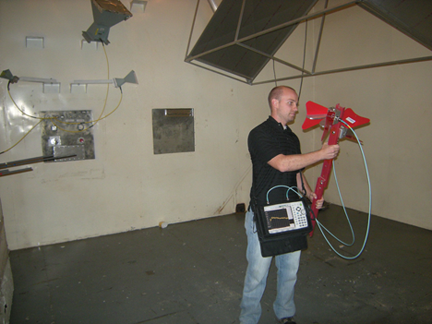
Figure 1: Execution of the random-walk test technique
For the walk-around method, which utilizes tracking generator/spectrum analyzer Max Hold measurements, the results are a collection of maximum received power values across the swept frequency band. A full walk-around measurement is conducted a total of 12 times in the space. Hence, at a given frequency, there are 12 maximum received power data points. This number can be augmented by including maximum power data points at adjacent frequencies, a process associated with frequency stirring of the field distribution. The independence of these samples is established by the following arguments. First, the 12 maximum power data points at any given frequency are spatially uncorrelated, as it is virtually impossible that any two maximum data points will originate under identical transmit and receive antenna positioning given the 6 degrees of freedom for orienting the antenna mounting pole in the space during the 12 random walk-arounds. Secondly, the maximum power data points at two frequencies are further uncorrelated since their frequency difference Δf exceeds the Q-bandwidth of the overmoded cavity [5], i.e.,
![]() (1)
(1)
For Q values on the order of 1000 in a submarine below-deck space at 2.4 GHz, Δf is on the order of 2-3 MHz. The maximum fractional bandwidth around the center frequency f that can be utilized for frequency stirring is limited by the fact that insertion loss (and hence Q) is frequency dependent, and insertion loss bias in the data must be avoided. For the statistical analysis of this paper, 108 maximum power data points are utilized – 12 maximum values at each of 9 adjacent frequencies (10 MHz separation) centered at 2.437 GHz.
The 80-MHz bandwidth yields a 3.3 % fractional bandwidth.
The statistical analysis of data obtained from the random-walk measurement technique essentially works “backward” from maximum received power data towards determining the well-known complex-cavity exponential (chi-squared Χ22 ) probability density function (pdf) for the random variable of received power from a linearly polarized antenna in the space [6]. The walk-around process exploits both source stirring and volume sampling as the transmit and receive antennas are moved throughout the space. At a given frequency, the spectrum analyzer Max Hold measurement will retain the largest value w of received power Pi from N frequency sweeps executed during the random walk session,
![]() (2)
(2)
A sufficiently large sample of measured maximum received power values is collected over a given frequency bandwidth from each random-walk trial. The cumulative distribution function for the random variable w is given by,
![]() (3)
(3)
This cumulative distribution function is derived from the extreme value theory of statistics for an underlying (parent) exponential probability density function (Χ22 ). α and β are, respectively, location and shape parameters of the distribution function. These distribution parameters are estimated from the mean μw and standard deviation σw of the measured values of w. The mean-normalized standard deviation of the maximum power data samples is given by,
![]() (4)
(4)
The shape parameter β is estimated from the following constraint,
 (5)
(5)
where,
![]() (6)
(6)
The integral quotient I(β) is a monotonically decreasing function with increasing β. Therefore, the solution of (5) for β is unique and globally convergent for any initial guess for β in the nonlinear root solver. The solution of (5) for β as a function of Sn is provided in Figure 2.

Figure 2: Estimation of maximum power distribution parameter β from the normalized standard deviation Sn of measured maximum power data samples.
Once β has been estimated, the following estimate for the location parameter α is obtained as,
 (7)
(7)
where γ = 0.577 is Euler’s constant. The maximum power distribution function (3) with parameters β and α estimated by (5) and (7) respectively has proven to yield remarkably good fits to measured maximum power data samples in ship and submarine below-decks spaces.
A confidence level can now be established from the probability function in (3) such that the maximum received power wx for a given input power Pinput is not expected to exceed the value on the right-hand-side of (8),
![]() (8)
(8)
where x is the one-sided confidence level, e.g., x = 0.95 [7]. A cavity calibration factor (CCF), or normalized electric field in V/m/√W, characterizes the EME in the space [4],
 (9)
(9)
where wx is taken as the upper-bound equality in (8). The quantity ηRx is the efficiency of the receive antenna.
Once the cavity calibration factor has been determined for a space, the maximum electric field component amplitude in that space can be predicted to the given confidence level for any input power Pinput. For source-victim separations greater than a critical distance governed by free-space loss and antenna directivity, the maximum electric field at the victim will be dominated by the diffuse (multipath) field and can be estimated by,
![]() (10)
(10)
where Pinput is the total amount of power radiated into the space at the given frequency. (Pinput is the summation of radiated power from each source in case of multiple emitters.) If the multiple sources are emitting at different frequencies within a given bandwidth, the superimposed maximum field environment can be approximated as the root-sum-square of the maximum fields established at each frequency by the sources. This is a necessary consideration if these multiple frequencies are within the susceptibility bandwidth of the equipment.
Measurements
The results of random-walk measurements with tracking generator/spectrum analyzer frequency sweeps on Max Hold are provided for two submarine spaces – one with high CCF, one with low CCF.
The random-walk technique is expected to report maximum values that would be generated from a large number of independent received power measurements obtained as the volume is source stirred and spatially sampled during the walk-arounds. Hence, measured data will demonstrate a “tight” variance in the maximum power distribution. This is confirmed by the very small variations of ±1-2 dB observed in the measured maximum power values in the laboratory setting of the reverberation chamber [6]. In the very complex environment of the submarine below deck, the variation in the collected maximum power data samples is expectedly larger, on the order of ±3-4 dB. This effect is demonstrated in the max-hold traces for the 12 walk-around trials in the submarine.
In addition, the cumulative distribution function in (3), estimated from the 108 maximum power data samples, is also obtained. A visual check on the statistical distribution function fit to the measured maximum received power data is provided. Lastly, the maximum electric field is predicted to a specified confidence level as a function of power emitted into the space. The predicted electromagnetic environment is compared to a maximum level specified for below-deck spaces in MIL-STD-464C [8].
The measured results for the high-CCF space are shown in Figures 3-5. The measured max-hold traces for the 12 walk-around trials are shown in Figure 3. The corresponding cumulative distribution function, estimated from 108 maximum power data samples around 2.437 GHz , is shown in Figure 4. The cavity calibration factor CCF0.95 = 20.3 V/m/√W. In Figure 5, the maximum electric field environment is predicted at the 95% confidence level as a function of total radiated power (TRP) into the space.
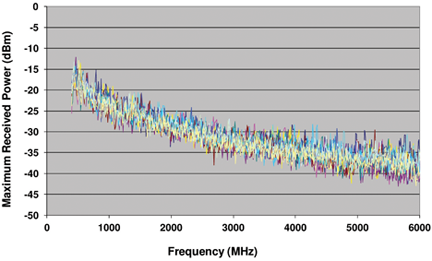
Figure 3: Maximum received power measurements from 12 walk-around trials in high-CCF space in submarine. Input power is 0 dBm.

Figure 4: Cumulative distribution function of maximum received power values in high-CCF space in submarine. Input power is 0 dBm at 2.437 GHz.
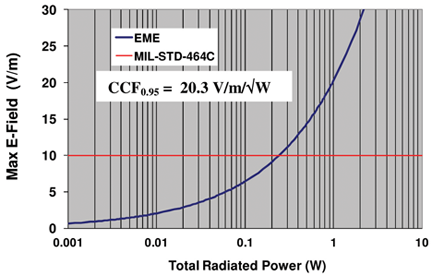
Figure 5: Maximum electric field predicted at 95% confidence level as a function of total radiated power into high-CCF space in submarine at 2.437 GHz.
The measured results for the low-CCF space are shown in Figures 6-8. The measured max-hold traces for the 12 walk-around trials are shown in Figure 6. The corresponding cumulative distribution function, estimated from 108 maximum power data samples around 2.437 GHz , is shown in Figure 7. The cavity calibration factor CCF0.95 = 10.1 V/m/√W. In Figure 8, the maximum electric field environment is predicted at the 95% confidence level as a function of total radiated power (TRP) into the space.

Figure 6: Maximum received power measurements from 12 walk-around trials in low-CCF space in submarine. Input power is 0 dBm.
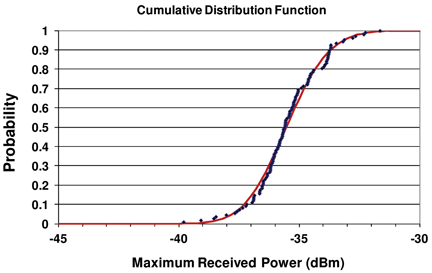
Figure 7: Cumulative distribution function of maximum received power values in low-CCF space in submarine. Input power is 0 dBm at 2.437 GHz.

Figure 8: Maximum electric field predicted at 95% confidence level as a function of total radiated power into low-CCF space in submarine at 2.437 GHz.
EMI Risk Mitigation
Wireless communications and sensor networks emit intentional radiated RF energy into the reverberant environment encountered in ship and submarine below-deck spaces. The resultant increase in the ambient electromagnetic environment (EME) has been identified as a cause of electromagnetic interference (EMI) to mission critical electronic equipments. Accordingly, interface controls are required to assure total system electromagnetic compatibility. MIL-STD-464C establishes electromagnetic environmental effects (E3) requirements for shipboard internal EME [8]. These EME limits are considerations when deploying wireless systems in below decks spaces.
EMI risk mitigation is based on alignment with a 10-V/m electric field radiated susceptibility requirement, RS103, of MIL-STD-461F [9] and guidance from MIL-STD-464C for ship internal EME. It is strongly recommended that electromagnetic compatibility testing of electronic equipment be conducted using a band-limited white Gaussian noise emission source in a reverberant test environment (a reverberation chamber or the actual/replicated in-situ below-deck space) [10]. Modern spread-spectrum digitally-modulated RF signals possess spectral and temporal properties that can present a more stressful waveform for interfering with electronic components and systems than can waveforms of CW or 50%-duty cycle 1-kHz pulsed signals. The wide power spectral density bandwidth, low temporal coherence time (rapid signal fluctuations), and large amplitude spikes of filtered white Gaussian noise RF emissions serve as upper-bound conditions for digitally modulated wireless RF emissions. Prior compatibility testing has been successful, but is costly and time-consuming, and verifies compatibility at only a single frequency and for a specific communications protocol. The development of a band-limited white Gaussian noise emission source capable of testing a wide swept frequency range, while providing a conservative worst-case test of digital wireless signal spectra and waveforms, enables a cost-effective electromagnetic compatibility test that can be used across all platforms.
The total radiated power (TRP) limit of 550 mW for multiple emitters in command and control spaces in surface ships is established in MIL-STD-464C to bound the total aggregate electric field that can build up in a reverberant space. The TRP limit can be applied individually to multiple, widely-separated frequency bands, such as uplink and downlink bands (e.g., 4G-LTE), or different WLAN bands (e.g., ISM, UNII). The maximum radiated power values from all emitters are summed to give the TRP value, giving consideration to available collision avoidance protocols, such as the carrier sense multiple access (CSMA) scheme.
The 550-mW TRP limit in MIL-STD-464C is obtained for a bounding condition CCF = 13.5 V/m/√W set from compiled measured data in command and control spaces. In spaces that have been shown by measurement
to have higher or lower reverberant property, i.e., a higher or lower cavity calibration factor (CCF), the TRP limit should be set at,
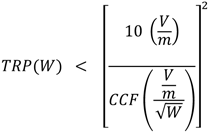 (11)
(11)
In below-deck volumes that are not well-defined confined spaces, a 30-ft. radius sphere centered about each fixed access point can be used to identify individual sub-spaces contained within the larger volume. The TRP limit is applied within each spherical sub-space.
Conclusion
The electromagnetic environment created in ship and submarine below-deck spaces by wireless network RF emissions can be predicted from a cavity calibration factor (CCF) derived from in-situ maximum received power measurements and statistical complex cavity theory. A random-walk test technique has been developed and applied to measurements conducted in these reverberant spaces. With maximum field strengths predicted to a specified confidence level, it becomes possible to assess the compatibility of the wireless network with mission critical electronic equipments based on the MIL-STD-464C standard. Such assessments rely on knowledge of radiated power characteristics of all emitters and need to be informed by specific wireless network configuration and operating protocols. The use of band-limited white Gaussian noise as a stressful modulation waveform for robust susceptibility testing of electronic equipment and systems is also advocated as an up-front approach to risk mitigation.
![]()
References
- G.B. Tait, R.E. Richardson, M.B. Slocum, M.O. Hatfield, and M.J. Rodriguez, “Reverberant Microwave Propagation in Coupled Complex Cavities,” IEEE Transactions on Electromagnetic Compatibility, Vol. 53, No. 1, pp. 229-232, Feb. 2011.
- G.B. Tait, R.E. Richardson, M.B. Slocum, and M.O. Hatfield, “Time-Dependent Model of RF Energy Propagation in Coupled Reverberant Cavities,” IEEE Transactions on Electromagnetic Compatibility, Vol. 53, No. 3, pp. 846-849, Aug. 2011.
- G. Tait, M. Slocum, D. Hilton, C. Dilay, and D. Southworth, “Off-Hull Radio Frequency Emissions from Below-Deck Spaces in Ships,” in Proc., 2010 IEEE International Symposium on EMC (Ft. Lauderdale, FL), July 2010, pp. 875-880.
- IEC 61000-4-21, Electromagnetic Compatibility (EMC) – Part 4-21: Testing and measurements techniques – Reverberation chamber test methods, International Electrotechnical Commission, 2008.
- D.A. Hill, Electromagnetic Fields in Cavities: Deterministic and Statistical Theories. New York: Wiley-IEEE Press, 2009.
- G.B. Tait and M.B. Slocum, “Random Walk Technique for Measuring the Electromagnetic Environment in Electrically-Large Reflective Spaces,” IEEE Transactions on Instrumentation and Measurement, Vol. 60, No. 3, pp. 1003-1009, March 2011.
- N. Wellander, O. Lunden, and M. Backstrom, “The maximum value distribution in a reverberation chamber,” in Proc. IEEE Int. Symp. Electromagnetic Compatibility (Montreal, Canada), Aug. 2001, vol. 2, pp. 751-756.
- DoD Interface Standard MIL-STD-464C: Electromagnetic Environmental Effects Requirements for Systems, Department of Defense, Dec. 2010.
- DoD Interface Standard MIL-STD-461F: Requirements for the Control of Electromagnetic Interference Characteristics of Subsystems and Equipment, Department of Defense, Dec. 2007.
- C. Lins-Morstadt, M. Slocum, and G. Tait, “Emission Source for Compatibility Testing of Wireless Networks in the Below-Deck Environment on Ships,” in Proc., 2012 IEEE International Symposium on EMC (Pittsburgh, PA), Aug. 2012, pp. 480 – 485.
 |
Gregory Tait is currently an electrical engineer with the Electromagnetic and Sensor Systems Department at the Naval Surface Warfare Center Dahlgren Division in Dahlgren, VA. He earned the PhD degree in Electrical Engineering from The Johns Hopkins University. Areas of current interest include stochastic electromagnetics in complex cavities and wireless signal propagation in coupled reflective spaces. |
 |
Paul Opperman is an electrical engineer with the Submarine Electromagnetic Environmental Effects (E3) Branch at the Naval Undersea Warfare Center in Newport, RI. He holds a Bachelor of Science degree in Electrical Engineering from Boston University. His current efforts include platform level E3 design of submarines, wireless system integration, E3 modeling, and intelligent data processing. |
